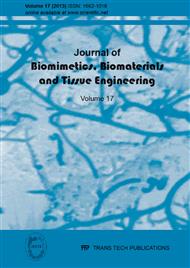[1]
M. Moravej, D. Mantovani. Biodegradable metals for cardiovascular stent application: interest and new opportunities. Int. J. Mol. Sci., (2011), 12 (7), 4250-70.
DOI: 10.3390/ijms12074250
Google Scholar
[2]
E. Ma, J. Xu. Biodegradable Alloys: The glass window of opportunities. Nature Materials, (2009), 8, 855-57.
Google Scholar
[3]
H. Hermawan, D. Dubé, D. Mantovani. Degradable metallic biomaterials: design and development of Fe-Mn alloys for stents. J. Biomed. Mater. Res. A, (2010), 93(1), 1-11.
DOI: 10.1002/jbm.a.32224
Google Scholar
[4]
B. Liu, Y.F Zheng, L. Ruan. In-vitro investigation of Fe30MnSi shape memory alloy as a potential biodegradable material. Materials Letters, (2011), 65, 540-543.
DOI: 10.1016/j.matlet.2010.10.068
Google Scholar
[5]
A. Lendlein, A.T Neffe, B.F Pierce, J. Vienken. Why are so few degradable polymeric biomaterials currently established in clinical applications? Int. J. Artif. Organs, (2011), 34 (2), 71-75.
DOI: 10.5301/ijao.2011.6422
Google Scholar
[6]
D. Persaud-Sharma, A. McGoron. Biodegradable magnesium alloys: a review of material development and applications. J. Biomim., Biomater. Tiss. Eng., (2012), 12, 25-39.
DOI: 10.4028/www.scientific.net/jbbte.12.25
Google Scholar
[7]
Z.G Huan, M.A Leeflang, J. Zhou, L.E Fratila-Apachitei, J. Duszczyk. In-vitro degradation behavior and cytocompatibility of Mg-Zn-Zr alloys. J. Mater. Sci.: Mater. Med., (2010), 21 (9), 2623-35.
DOI: 10.1007/s10856-010-4111-8
Google Scholar
[8]
V.M Babkin. Effect of zirconium on the grain size of magnesium containing 4.5% Zn. Metal Sci. Heat Treat., (1963), 5 (9), 543-44.
DOI: 10.1007/bf00648969
Google Scholar
[9]
J.M Benson. Safety considerations when handling metal powders. J. South African Instit. Mining and Metallurgy, (2012), 112 (7), 563-75.
Google Scholar
[10]
M. Rederstoff, A. Krol, A. Lescure. Understanding the importance of selenium and selenoproteins in muscle function. Cell. Mol Life Sci., (2006), 63 (1), 52-9.
DOI: 10.1007/s00018-005-5313-y
Google Scholar
[11]
D.L Hartfield. Introduction to Selenium, Selenium: Its Molecular Biology and Role in Human Health. (2001). Springer, Boston.
Google Scholar
[12]
J.R Turnlund. Copper, in: M.E Shils, M. Shike, A.C Ross, B. Caballero, R.J Cousins. Modern Nutrition in Health and Disease. 10th edition. Philadelphia: Lippincott, Williams & Wilkins. (2005), 286-99.
Google Scholar
[13]
M.Angelova, S. Asenova, V. Nedkova, R. Koleva-Kolarova. Copper in the Human Organism. Trakia J. Sciences, (2011), 9 (1), 88-98.
Google Scholar
[14]
D. Persaud-Sharma, N. Budiansky, A. McGoron. Mechanical properties and tensile failure analysis of novel-bioabsorbable Mg-Zn-Cu and Mg-Zn-Se Alloys for endovascular applications. Metals, (2013), 3, 23-40.
DOI: 10.3390/met3010023
Google Scholar
[15]
L.M Gaetke, C.K Chow. Copper toxicity, oxidative stress, and antioxidant nutrients. Toxicology, (2003), 189 (1-2), 147-63.
DOI: 10.1016/s0300-483x(03)00159-8
Google Scholar
[16]
R. Alvarez, H. Martin, M.F Horstemeyer, M. Chandler, N. Williams, P. Wang, A. Ruiz. Corrosion relationship as a function of time and surface roughness on a structural AE44 Magnesium alloy. Corrosion Sci., (2010), 52 (5), 1635-48.
DOI: 10.1016/j.corsci.2010.01.018
Google Scholar
[17]
R. Walter, B. Kannan. Influence of surface roughness on the corrosion behavior of magnesium alloy. Mater. and Design, (2011), 32 (4), 2350-54.
Google Scholar
[18]
D. Persaud-Sharma, N. Munroe, A.J McGoron. Electro and magneto-electropolished surface micro-patterning on binary and ternary Nitinol. Trends Biomater. Artif. Organs, (2012), 26 (2), 74-85.
Google Scholar
[19]
P.C Hiemenz, R. Rajagopolan. Principles of Colloid and Surface Chemistry, (1997), 3rd Edition, Marcel Dekker, Inc.
Google Scholar
[20]
K. Grundke. Wetting, Spreading, and Penetration, in: Handbook of Applied Surface and Colloid Chemistry. (2002), K. Holmberg, Editor, John Wiley & Sons, Ltd.
Google Scholar
[21]
T. Young. An Essay on the Cohesion of Fluids. Philosophical Transactions of the Royal Society of London. (1805), 95, 65-87.
DOI: 10.1098/rstl.1805.0005
Google Scholar
[22]
R.N Wenzel. Resistance of Solid Surfaces to wetting by Water. Ind. Eng Chem., (1936), 28 (8), 988-94.
Google Scholar
[23]
A.B.D Cassie, S. Baxter. Wettability of Porous Surfaces. Trans. Faraday Soc., (1944), 40, 546-51.
DOI: 10.1039/tf9444000546
Google Scholar
[24]
D. Chen, Y. He, H. Tao, Y. Zhang, Y. Jiang, X. Zhang, S. Zhang. Biocompatibility of magnesium-zinc alloy in biodegradable orthopedic implants. Int. J. Mol. Med., (2011), 28 (3), 343-48.
DOI: 10.3892/ijmm.2011.707
Google Scholar
[25]
G.J Brewer. The risks of copper-toxicity contributing to cognitive decline in the aging population and to Alzheimer's disease. J. Am. Coll. Nutr., (2009), 28 (3), 238-42.
Google Scholar
[26]
A.P Marques, R.L Reis, J.A Hunt. The biocompatibility of novel starch-based polymers and composites: in-vitro studies. Biomater., (2003), 23 (6), 1471-78.
DOI: 10.1016/s0142-9612(01)00272-1
Google Scholar
[27]
I.S Berglund, H.S Brar, N. Dolgova, A.P Acharya, B.G Keselowsky, M. Sarntinoranont, M.V Manuel. Synthesis and Characterization of Mg-Ca-Sr alloys for biodegradable orthopedic implant applications. J. Biomed. Mater. Res. B Appl. Biomater., (2012), 100 (6), 1524-34.
DOI: 10.1002/jbm.b.32721
Google Scholar
[28]
M. Bornapour, N. Muja, D. Shum-Tim, M. Cerruti, M. Pekguleryuz. Biocompatibility and biodegradability of Mg-Sr alloys: The formation of Sr-substituted hydroxyapatite. Acta Biomater., (2013), 9 (2), 5319-30.
DOI: 10.1016/j.actbio.2012.07.045
Google Scholar
[29]
S. Itoh, H. Kim, O. Nakagawa, K. Ozumi, S. Lessner, H. Aoki, K. Akram, R. McKinney, M. Ushio-Fukai, T. Fukai. Novel role of antioxidant-1 (Atox1) as a copper-dependent transcription factor involved in cell proliferation. J. Biol. Chem., (2008), 283 (14), 9157-67.
DOI: 10.1074/jbc.m709463200
Google Scholar
[30]
S. Keim, J. Brunner, B. Fabry, S. Virtanen. Control of magnesium corrosion and biocompatibility with biomimetic coatings. J. Biomed. Mater. Res. B App. Biomater., (2011), 96 (1), 84-90.
DOI: 10.1002/jbm.b.31742
Google Scholar
[31]
R.E Baier, A.E Meyer, J.R Natiella, R.R Natiella, J.M Carter. Surface properties determine bioadhesive outcomes: methods and results. J. Biomed. Mater. Res., (1984), 18 (4), 337-55.
DOI: 10.1002/jbm.820180404
Google Scholar
[32]
P. van der Valk, A.W van Pelt, H.J Busscher, H.P De Jong, C.R Wildeyuur, J. Arends. Interaction of fibroblasts and polymer surfaces: relationship between surface free energy and fibroblasts spreading. J. Biomed. Mater. Res., (1983), 17: (5), 807-17.
DOI: 10.1002/jbm.820170508
Google Scholar
[33]
Y. Xin, C. Liu, X. Zhang, G. Tang, X. Tian, P. Chu. Corrosion behavior of biomedical AZ91 magnesium alloy in simulated body fluids. J. Mater. Res., (2007), 22 (7), 2004-11.
DOI: 10.1557/jmr.2007.0233
Google Scholar
[34]
M.F Morks. Magnesium phosphate treatment of steel. Materials Letters, (2004), 58 (26), 3316-19.
DOI: 10.1016/j.matlet.2004.06.027
Google Scholar


